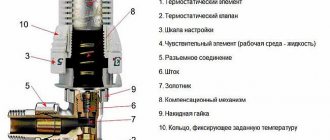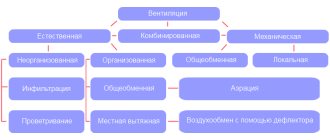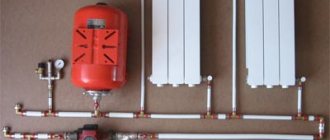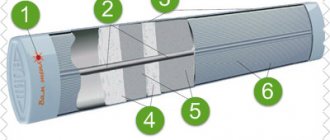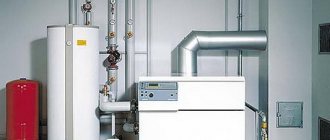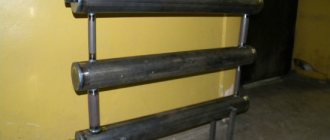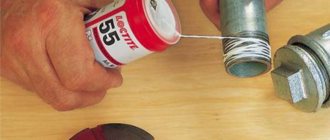Types of mud filters
By type of particle screening. In a mesh mud pan, dirt and other elements are captured by a metal mesh, and then retained in the storage area of the filter.
Cleaning the heating system sump is simple - you just need to unscrew the filter, and then rinse it and clean it mechanically with brushes.
There are filters with magnetic elements; they capture metal particles that inevitably appear in the water of the heating circuit.
By type of service
- Self-cleaning. The sediment that settles at the bottom of the glass is automatically washed away by a stream of water, so there is no need to maintain such dirt traps.
- Non-flushing. In this case, after prolonged operation, the CO section needs to be partially dismantled to replace the filter element.
- Flushing. The filter glass needs to be systematically cleaned using running water and soft brushes.
By installation type
- Mud collectors with a coupling type of connection. To install such a filter, you will need a set of wrenches.
- Filters with a flange modification of the connection are joined through an O-ring, and tightened along the edges of the connection with bolted fasteners.
- Mud traps with a PP pipe circuit are used mainly for small cross-section pipes.
Classification based on filtering principle
Mesh filters . The most common and familiar type of mud filter for water used in everyday life. In the simplest design, dirt is retained by the mesh and deposited in the accumulation zone. Periodically, the bottom of the glass is turned away and the dirt is removed. The design can be supplemented with a drain valve installed instead of the bottom, and then the mud pan turns from a flushing one into a self-flushing one.
Strainer Danfoss FVR, DN50.
Installing an additional mesh that removes air from the coolant, a float and a needle valve adds the function of protecting the mud pan from gas contamination. The efficiency of the mesh sump depends on the pressure in the line before and after it. If there is a significant difference in these values, solid particles can be forced through the mesh.
A magnetic filter removes metal particles from the coolant flow. When such a filter operates, there is no braking effect on the fluid flow, which is important when operating powerful pumps.
There are also inertial-gravity and subscriber mud collectors. The principle of operation of the former is clear from their name and they are used in large enterprises. Subscriber devices clean the coolant at the entrance to the metering units.
Principle of operation
The principle of operation of a self-flushing dirt trap is based on slowing down the flow rate of the coolant:
- The coolant, when it is inside the housing of the filter element, begins to move at a lower speed. This happens due to the fact that the diameter of the pipeline expands in this section. Therefore, under the force of gravity, the particles precipitate.
- After this, the liquid flows through the filter located at the outlet pipe, and then goes into the main pipeline.
- Removal of accumulated dirt and particles is carried out through a drain pipe or cap, which is separated by ball valves. After each cleaning, it is important to check for leaks, rust on connections, and so on.
Attention! We recommend installing a hydraulic resistance sensor into your system, in this case you will always know when it is necessary to clean the dirt trap. You just need to install it strictly following the instructions from the manufacturer, in which case it will display reliable data.
Varieties
To reduce the risk of boiler breakdown, increase the accuracy of measuring instruments and ensure a long service life of the equipment, it is important to understand the main types of devices and choose the right one
Polyphosphate
Polyphosphate units are considered a budget option for pre-purification and softening of water entering the boiler.
The operating principle of such a device is to pass liquid through a flask filled with special crystals. They ensure the formation of a protective film on the inner walls of the boiler and also slow down the formation of scale.
Photo 1. Polyphosphate filter for a gas boiler, filled with special crystals. They slow down scale formation.
The devices have a simple design:
- drain;
- flask;
- filler;
- lid.
The liquid enters the flask with filler through the lid, where it is passed through polyphosphate crystals. Next, it goes through the drain into the gas boiler tank.
Any device of this type requires periodic replacement of the filler - sodium salt crystals. As a matter of fact, this is the only difficulty in servicing them. The average lifespan of such a treatment plant is up to one and a half years.
Electromagnetic or magnetic for softening hard water
Electromagnetic devices are expensive, but the price is completely justified: the installation lasts a long time and allows you to obtain perfectly clean water at the output.
The principle of operation is that when the liquid passes through the flask, the salts in it disintegrate. Thus, scale will not settle on the walls of the boiler. Instead, the filter itself will be clogged with tiny salt particles, which is periodically washed.
Photo 2. Three magnetic filters for a heating system boiler; the scale in them breaks down into tiny particles.
Another characteristic is that under the influence of electromagnetic radiation, not only does the scale disintegrate into small particles, but also a thin film is formed that covers the boiler heat exchanger. Thanks to this, it remains protected and does not corrode for a long time.
We should not forget that electromagnetic and magnetic devices are different installations. At the heart of both is a magnet.
Attention! Electromagnetic devices are more powerful because they require connection to an electrical network. Ideal for gas boilers, as they perfectly soften water of any temperature
Magnetic installations are less strong and are not recommended for use with gas boilers if the water hardness is too high.
Magnetic devices consist of a metal case, inside of which there are a large number of strong magnets. Electromagnetic devices are additionally equipped with an electric drive, the operation of which allows the effect of magnets to be greatly enhanced.
Cartridge for cleaning
Cartridge devices have low throughput. The following device types exist:
- Mechanical - traps small debris. Such devices need to be cleaned frequently, and they do not soften the water.
- Coal - purify water due to activated carbon, which acts as a filler. If you do not change it in time, the water will become even more contaminated as a result of passing through the filter.
Photo 3. Four low-flow cartridge filters are needed to purify the water.
- Ion exchange cartridge devices are considered the best, as they change the hardness of water by entering into a chemical reaction with calcium and magnesium ions.
- Osmotic - allow molecules of water and gas to pass through them. This allows you to clean the liquid from metal impurities and harmful microorganisms, but it will not be possible to soften the water by installing such a filter.
- Membrane - purify water from debris and impurities, but do not soften it.
Important! Cartridge filters are not suitable for gas boilers (with the exception of ion exchange devices). They are more focused on purifying the water you are supposed to drink.
Advantages and disadvantages
Advantages
- Installing a mud trap significantly extends the life of the main heating system equipment (radiators, connections, pump, etc.).
- Reduced fuel costs. It is very simple to justify this: if there are fewer particles and dirt in the pipeline, then the heat transfer is good, which means the fuel is fully consumed.
- Complete protection of the convective units of the heat generator.
Flaws
- If the coolant in the system has been dirty for a long time, then you will have to clean the mud trap many times.
How to install a mud pan
Before direct installation and purchase of materials, you should create a more or less accurate plan for the heating system. After this, you need to identify the most successful places for installing a mud trap; when drawing up an installation diagram, you should take into account as many nuances as possible: contour turns, bends and flow speed.
Installation is carried out taking into account the following recommendations:
- Dirt traps are installed exclusively on horizontal sections of the circuit.
- Installation is carried out between 2 ball valves.
- A mud trap is installed in front of the water flow sensor (if you have one built into the CO).
How to properly install a mud trap in a heating system, follow these instructions:
- First, all the coolant is drained from the heating system (if there are no shut-off valves nearby).
- Then a section of horizontal pipeline no more than 1 meter is cut out with a grinder (if the pipes are steel) or cut with a pipe cutter (if the pipes are polypropylene)
- Fittings are soldered or screwed in to connect ball valves.
- After this, small sections of pipes and the mud tank itself are connected. It should be oriented strictly downwards, and at an acute angle towards the flow.
- At the end of the system operation, the system is filled with coolant, the air is vented, and then the filter system is tested for leaks.
Before installing the mud pan, do not forget to carefully read the instructions from the manufacturer.
Important! When purchasing, it is important to consider the size of the mud traps for the heating system, as they should trap contaminants with the greatest efficiency.
Prevention
A conventional coarse filter, as a rule, is not installed in an easily accessible place. Therefore, preventative cleaning is difficult. Moreover, its design is designed in such a way as not to allow dirt to pass through, even when it is completely clogged. And the degree of clogging is often determined by the decrease in the intensity of water supply from the mixer.
Attention. If the mud trap is easily accessible and there is no seal on it, then preventive cleaning should be done once every 6 months.
However, the manufacturer recommends cleaning models that provide pressure cleaning (water pressure when opening the valve) or cassette samples at least once every six months . But such specimens often have a transparent body, which helps to visually determine the degree of “clogging” of the filter.
How to maintain a dirt filter
Service algorithm:
- If the heating system begins to work incorrectly, the first thing you need to do is stop the circulation pump.
- Next, turn off the taps on both sides of the filter.
- Next, the connection securing the mud catcher is unscrewed.
- The filter glass is washed and cleaned well by any means.
- Next, assembly is performed in reverse order.
Additionally, you can clean the section of the pipe adjacent to the mud trap; this can be done with a long, strong stick or wire with a foam sponge attached.
We hope that you have carefully studied our article and now understand how to install a mud trap on a heating system. We wish you all the best, do not forget to periodically clean the mud pan, and then the heating system will serve you faithfully for several decades!
